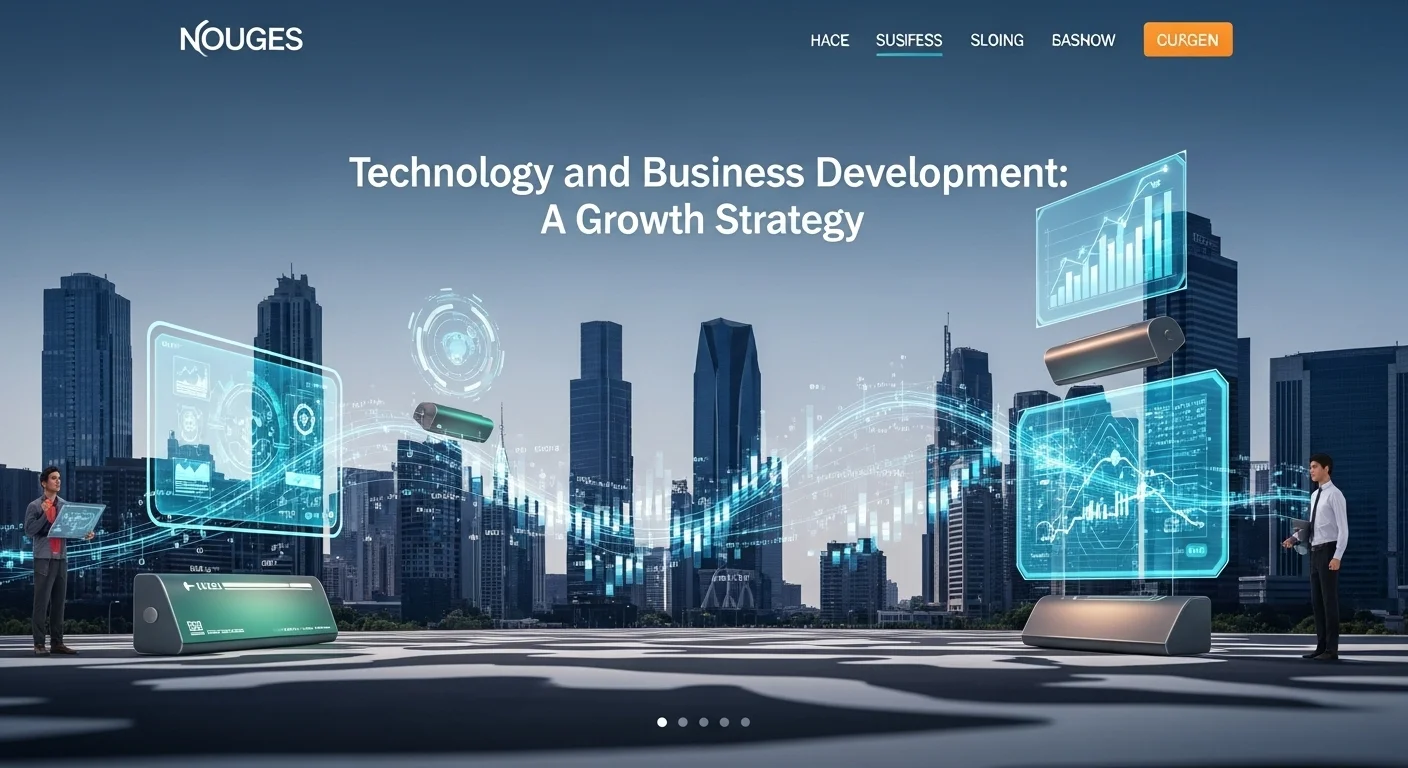How Technology Is Revolutionizing Business Development: A Guide to Real Growth

Executive Summary
I’ve been in business development for over 15 years, and the change I’ve witnessed is staggering. What used to be a game of handshakes and intuition is now a sophisticated fusion of technology and strategy. This shift is the single most important factor for corporate growth today. In this article, I'm going to walk you through the critical role technology now plays, from using data to find hidden market opportunities to leveraging AI as a strategic partner, not just a tool. We’ll explore how both startups and established giants can use tech to build powerful partnerships and create lasting value. I'll share practical ways to use AI for business development, some fresh ideas for startups, and even how these concepts can be adapted for emerging markets. Think of this as your personal guide to navigating the modern market and using technology to put your organization on a path to real, sustainable growth.
Table of Contents
Table of Contents
- What is Business Development and Why Does It Matter in Tech?
- A Complete Guide to Business Development in Technology
- Actionable Tips and Strategies to Improve Your Tech BD
What is Business Development and why is it important in Technology?
Let's get straight to it. Think of Business Development (BD) as the engine that drives a company forward. It’s more than just high-level sales; it's the art and science of creating long-term value through a mix of strategy, partnerships, and smart relationship-building. In the world of technology, its role is absolutely critical. We're not just selling a product; we're trying to weave our company's innovations into the fabric of the market. In my experience, great tech can fail without great BD to build the bridges—to partners, new markets, and strategic opportunities—that ensure its success and leadership.
Years ago, a business developer was often just a senior salesperson. In tech today, that definition is far too narrow. A good BD professional is a strategist, a negotiator, a market analyst, and a relationship guru all in one. They might be brokering a crucial integration between two software platforms or mapping out a hardware company's entry into a new continent. They are the essential link between the brilliant minds building the product and the outside world that needs to use it.
The Evolution of Business Development in the Digital Age
The digital boom has completely rewritten the BD playbook. The arrival of big data, cloud infrastructure, and constant connectivity has given us a toolkit I could have only dreamed of a decade ago. Market research used to mean tedious surveys and expensive reports. Now, I can analyze real-time market data, see what competitors are doing online, and identify the perfect potential partner using sophisticated analytics. The journey a customer takes is no longer a straight line. It's a dynamic path involving social media, content, and digital networking. This data-first approach allows us to be incredibly precise, personal, and deeply in tune with customer needs. We've moved from gut feelings to evidence-backed strategies. A modern BD pro has to be as fluent in reading a CRM dashboard as they are in navigating a boardroom.
The Strategic Imperative of BD in Tech Companies
In technology, if you’re standing still, you're falling behind. Innovation is relentless, and your next competitor could pop up anywhere. This is why business development is not just a function; it's a strategic necessity. Here’s why it's so vital:
- Fueling Revenue Growth: This is the most obvious one. By opening new markets, landing key accounts, and building profitable partnership channels, BD directly powers the company's bottom line.
- Strengthening Market Position: I’ve seen small startups gain immense credibility overnight by partnering with an industry leader. Strategic partnerships can elevate your brand and make your product essential to users.
- Driving Innovation: We are the company's eyes and ears on the ground. The feedback we gather from customers and partners is gold for the product team. We can spot market gaps and user needs that spark the next big feature or product.
- Building a Resilient Business: A company that relies on a single market or revenue stream is fragile. BD builds diversification by creating a web of revenue sources, markets, and partnerships, making the business strong enough to weather any storm.
Introducing AI for Business Development: A New Frontier
The most exciting and transformative shift happening right now is the rise of Artificial Intelligence. Using AI for business development isn't some sci-fi concept anymore; it's a practical advantage that early adopters are using to dominate. AI tools are automating and enhancing every single step of the BD process. For example, AI platforms can sift through mountains of data to pinpoint your ideal customer with scary accuracy. They can score leads on their probability of converting, so your team focuses only on the hottest opportunities. This is a complete game-changer for how AI business development works, shifting us from manual grunt work to intelligent, automated workflows that free us up for high-level strategy and human connection.
Practical Applications: Employing AI for Business Development
The ways we are employing AI for business development are expanding every day. Here are a few real-world examples:
- Smarter Lead Generation: AI platforms can scan websites, social media, and news to find companies showing buying signals. This is far beyond keyword matching; it uses natural language processing (NLP) to understand what's really going on.
- Predictive Forecasting: By analyzing past sales data and market trends, AI can predict future demand, spot emerging markets, and even warn you which customers might be about to leave. This allows us to be proactive, not reactive.
- Conversation Intelligence: Tools like Gong and Chorus use AI to analyze sales calls. I've used them to get incredible insights into what my top performers do differently and which messages truly connect with customers.
- Partnership Matching: AI can analyze your company’s product and goals to recommend potential partners that have the highest chance of a successful and profitable collaboration.
Bringing these tools into your workflow makes the entire BD function more efficient, data-backed, and ultimately, more successful.
Business Development Ideas for Startups: Lean and Agile Growth
For a startup, business development isn't about hiring a huge team. It's about being smart, agile, and strategic. Some of the biggest names in tech grew through clever BD, not massive ad budgets. Here are some of my favorite business development ideas for startups:
- Focus on Integration Partnerships: If you have a SaaS product, integrating with other popular tools is a superpower. It adds instant value for your customers and exposes your brand to a whole new audience.
- Become a Thought Leader: Create genuinely useful content—blogs, whitepapers, webinars—that solves your audience's problems. This builds trust and attracts inbound leads, giving you a warm way to start conversations with key prospects.
- Build Your Tribe: Create a community around your product or industry. This could be a Slack group, a forum, or local events. A vibrant community becomes your best source of feedback, testimonials, and evangelists.
- Use Freemium Strategically: Offer a free version of your product that is genuinely useful. This isn't just a trial; it's a powerful lead-generation machine. Once users see the value, your BD team has the perfect opportunity to upsell them.
Global Opportunities: Small Business Ideas for Developing Countries
These tech-driven BD principles have incredible potential to spark entrepreneurship in emerging economies. Technology can bypass traditional barriers and create new markets. Here are some small business ideas for developing countries built on this model:
- Agritech Platforms: Imagine a simple mobile app that gives farmers real-time data on weather, market prices, and farming techniques. This can dramatically boost their income. The BD work here is building partnerships with farmer co-ops and local suppliers.
- Mobile-First Fintech: In many countries, more people have a mobile phone than a bank account. Fintech startups offering mobile wallets, micro-loans, and digital payments can drive huge financial inclusion. BD focuses on building a network of trusted local merchants and agents.
- Telemedicine Services: A platform connecting patients in remote areas to doctors via video call can be a lifesaver. Business development would focus on partnering with local clinics and pharmacies to build a trusted network.
- Low-Bandwidth Edtech: Educational platforms offering curriculum content on low-bandwidth mobile apps can close huge learning gaps. The key to scale is BD-led partnerships with schools, NGOs, and governments.
In every case, technology provides the tool, but business development—building the right go-to-market strategy and partnerships—is what creates success and real-world impact. It’s the human element that ensures innovation reaches the people who need it most.

Complete guide to Business Development in Technology and Business Solutions
A successful business development strategy in tech is a careful mix of proven methods, modern tools, and a gut-level understanding of the landscape. It's a discipline that, when you get it right, can take a company from a small player to a market leader. In this guide, I'll break down the technical methods and business techniques that are the foundation of effective tech BD, always keeping an eye on how AI is changing the game.
Technical Methods: The Science of Business Development
Modern BD is more science than ever. It's built on structured processes and specialized tools that help you manage the journey from a new idea to a signed contract.
1. Market Research and Competitive Analysis
Before you make a single call, you have to do your homework. This isn't just a quick search; it's about deeply understanding the world you're operating in.
- Sizing Up the Market (TAM): First, you need a realistic picture of the total revenue opportunity out there for your product.
- Defining Your Ideal Customer (ICP): Create detailed, almost personal profiles of the perfect companies and people you want to work with. Who are they? What are their biggest challenges?
- Spying on the Competition: I use tools like Crunchbase and Similarweb to see what competitors are up to. What are their strengths? Where are they weak? This is a huge area for AI for business development, as AI can monitor competitor activity in real-time and alert you to a pricing change or a new product launch.
2. Lead Generation and Prospecting
This is all about filling your pipeline with potential opportunities. The old ways of doing this are mostly obsolete.
- Inbound (Letting them come to you): Attracting customers with valuable content like blog posts, webinars, and great SEO. This is the lifeblood of many modern SaaS companies.
- Outbound (Going out to get them): Proactively reaching out to your ideal customers. Today's outbound is hyper-personalized. I use tools like LinkedIn Sales Navigator and Apollo.io to find the right person and craft a message that speaks directly to their needs.
- AI-Powered Prospecting: This is where employing AI for business development is incredibly powerful. AI can spot 'buying signals' online—like a company suddenly hiring for a new role or researching a topic—that tell you they're ready to talk.
3. CRM and Pipeline Management
Your Customer Relationship Management (CRM) system is the brain of your BD operation. You can't function without one. Platforms like Salesforce or HubSpot are essential for:
- Tracking Everything: Every email, call, and meeting with a prospect gets logged. No more 'I think I called them last month.'
- Visualizing Your Pipeline: A clear, visual map of every deal, its value, and how likely it is to close.
- Forecasting Sales: Using past data to predict future revenue. Again, AI business development adds a layer of magic here. AI-driven CRMs can score leads, flag deals that are going cold, and even suggest the next best step to take.
4. Structuring Partnerships and Alliances
In tech, a partnership isn't a handshake. It's a carefully structured agreement. The most common types I work with are:
- Referral Partnerships: A simple deal to send business to each other for a fee.
- Integration Partnerships: Technically connecting two software products. This is a massive growth engine for SaaS companies.
- Reseller/Channel Partnerships: Giving another company the right to sell your product, often in a new country or market segment.
- Co-Marketing/Co-Branding: Teaming up on marketing campaigns or creating a joint product.
Each of these requires careful negotiation on everything from revenue sharing to technical support.
Business Techniques: The Art of Business Development
While tools give you the framework, the real art of BD comes down to human connection and strategic thinking.
1. Strategic Networking
Networking isn't about collecting contacts; it's about building real relationships. In tech, this happens at conferences, in niche online groups, and on LinkedIn. My goal is always to become a trusted advisor in my field, not just another salesperson.
2. Consultative Selling
The best in this business don't 'sell'; they 'solve.' This means taking the time to truly understand a prospect's problems and then showing them how your solution helps them achieve their goals. It's a shift from talking about your product's features to talking about the results and ROI they will see.
3. Content as a Conversation Starter
A great piece of content is the perfect excuse to start a conversation. A well-researched report or an insightful webinar shared with a high-value prospect positions you as an expert and shows you've done your homework. This is one of the most powerful business development ideas for startups on a tight budget.
4. Negotiation and Closing the Deal
Negotiation is a delicate dance. It's not about winning at all costs. It's about finding a win-win that builds a foundation for a great long-term relationship. This means knowing your bottom line, being crystal clear on the value you bring, and having the confidence to walk away if the deal isn't right.
Comparisons: Understanding the Nuances
Knowing the difference between related concepts helps you stay focused.
Business Development vs. Sales
This is the classic confusion. Sales is about closing deals and hitting near-term revenue targets. Business Development is about creating long-term value by building new markets, partnerships, and growth channels. Sales works with the leads they're given; BD often creates those leads from scratch through strategic initiatives.
Inbound vs. Outbound BD
Inbound BD is about pulling customers in with great content and brand building. Outbound BD is about proactively pushing your message out to specific target companies. In my experience, the most successful companies do both—they combine the scale of inbound with the precision of outbound.
Strategic Alliances vs. Mergers & Acquisitions (M&A)
A strategic alliance is a partnership between two independent companies. M&A is when one company buys another. BD professionals are often at the start of both processes, identifying companies that would be a good strategic fit for a partnership or an acquisition.
Adapting Strategies for Global Markets: Small Business Ideas for Developing Countries
These methods need to be adapted for different markets. When thinking about small business ideas for developing countries, localization is everything.
- Tech That Works: Solutions have to be designed for low-bandwidth internet and cheap smartphones. Mobile-first isn't a buzzword; it's a requirement.
- The Power of Local Trust: In many emerging markets, trust is built face-to-face. Partnering with respected local organizations or community leaders is far more effective than a generic marketing campaign.
- Flexible Payment Models: Monthly subscriptions often don't work. Models like pay-as-you-go, micro-transactions, or paying a local agent in cash are often the key to success.
- Solving Real-World Problems: The most successful ventures I've seen address fundamental needs like finance, healthcare, or education. An agritech platform that boosts a farmer's income by 20% will always beat a mobile game.
By blending a rigorous, data-driven approach with the art of human connection—and by adapting intelligently to the market—any tech company can build a powerful engine for growth. The integration of AI is the next phase of this evolution, making the entire process smarter and more predictive than we ever thought possible.

Tips and strategies for Business Development to improve your Technology experience
Getting business development right in the ever-changing tech world is a marathon, not a sprint. It's about constantly learning, adapting, and refining your approach. It takes a real commitment to best practices, a hunger for new tools, and the humility to learn from your mistakes. Here, I'll share some actionable tips, essential tools, and strategic insights that I've learned over the years to help you drive real growth.
Best Practices for Modern Tech Business Development
Following a few core principles can make a massive difference in your effectiveness.
1. Align BD with Overall Company Strategy
Your BD team can't be an island. I've seen it happen—great partnerships get sourced but die on the vine because the product team wasn't on board. BD has to be locked in step with product, marketing, and sales. Hold regular meetings to ensure everyone is aligned on the product roadmap, marketing messages, and revenue goals. The insights your BD team brings back from the market should directly influence what gets built next. This alignment is what turns effort into results.
2. Focus on Long-Term Relationship Value
It's tempting to chase quick wins, but great business development is about creating sustainable, long-term value. This means you have to prioritize relationships over transactions. Your goal is to build a network of partners and customers who will be your champions for years to come. Sometimes this means investing time in a partnership that won't pay off for a year, but has huge strategic importance. It's playing the long game.
3. Be Relentlessly Data-Driven
Your gut instinct is valuable, but the best decisions are always backed by data. Track everything: email response rates, funnel conversion rates, customer lifetime value (LTV), and customer acquisition cost (CAC). A/B test your messaging. Analyze which pieces of content generate the best leads. A data-driven approach tells you what's working so you can double down, and what's not so you can stop wasting time and money.
4. Never Stop Learning
The tech landscape changes in the blink of an eye. You have to be a student of the game. I dedicate time every week to reading industry news, listening to podcasts, and learning about new tools. Encourage your team to do the same. A culture of continuous learning is your best defense against becoming irrelevant, especially in the world of AI for business development, where things are moving at lightning speed.
Essential Business and Tech Tools for BD Professionals
The right tech stack is a force multiplier. It automates the boring stuff and gives you insights you'd otherwise miss.
- CRM (Customer Relationship Management): This is non-negotiable. Salesforce is the beast of the industry, powerful and endlessly customizable. For startups and smaller businesses, I often recommend HubSpot for its user-friendly design and fantastic marketing tools.
- Prospecting and Data Enrichment: Tools like ZoomInfo, Apollo.io, and LinkedIn Sales Navigator are my go-to's for finding the right people and their contact info. They give you the data you need for smart, targeted outreach.
- Sales Intelligence and Automation: This is where employing AI for business development really shines. Gong.io analyzes your sales calls to tell you what's working. Platforms like Outreach.io and SalesLoft automate your outreach sequences at scale. And I love tools like CrystalKnows, which uses AI to tell you the best way to communicate with a specific person based on their personality.
- Market and Company Intelligence: Crunchbase is essential for tracking startups and funding. For deeper research on private markets, M&A, and strategic partnerships, PitchBook is an invaluable resource.
Actionable Strategies and Tech Experiences
Case Study: An Integration-Led Growth Story
I remember working with a small B2B SaaS startup that made project management software. They were struggling to get noticed in a crowded market. Instead of blowing their budget on ads, their BD team adopted a single, brilliant strategy: integration partnerships. They identified the top 5 accounting and file-sharing tools their customers were already using. The BD team's only job was to build relationships with those companies and get an integration built. Within 18 months, they had done it. The results were explosive. It made their product sticky for existing customers and opened up a massive marketing channel, as their new partners promoted the integration to their own users. It was a perfect example of smart business development ideas for startups.
The Future is AI: Transforming the BD Role
The continued growth of AI business development is going to free us from the mundane. Repetitive tasks like data entry, initial prospecting, and scheduling will soon be fully automated. This will elevate the role of the BD professional, allowing us to focus on what humans do best:
- High-Level Strategy: Analyzing complex market trends and charting the course for long-term growth.
- Complex Negotiation: Structuring creative, high-value partnership deals that require nuance and trust.
- Relationship Management: Building deep, authentic relationships with the most important partners and clients.
- Creative Problem-Solving: Inventing new business models and innovative ways to enter new markets.
The BD professional of tomorrow will be less of a 'doer' and more of a 'strategist' and 'conductor,' using AI as a powerful orchestra to execute their vision.
Global Perspectives: Small Business Ideas for Developing Countries
Tech-driven BD can be a massive force for good. When brainstorming small business ideas for developing countries, the focus must be on accessible, affordable, and high-impact solutions.
- Micro-Franchising Tech Platforms: A platform that helps local entrepreneurs easily set up and manage a small business, like a solar-powered phone charging kiosk. The platform provides the tech, training, and supplies. BD focuses on recruiting entrepreneurs and partnering with microfinance organizations.
- Last-Mile Logistics Networks: Getting goods from a warehouse to a customer's door is a huge challenge in many cities. A tech platform that uses a network of local couriers on bikes or motorcycles can solve this. BD means signing up e-commerce sites and local shops as clients.
- Digital Identity Solutions: Without a formal ID, it's hard to get a bank account or government aid. A startup providing a secure, biometric digital ID on a mobile phone could unlock incredible economic opportunities. The core BD strategy would be partnering with banks and government agencies.
For those who want to go even deeper, the Technology and Innovation section of the Harvard Business Review is a fantastic resource. By mixing best practices with the right tools and a forward-thinking mindset, any business development professional can become the key driver of growth in their organization.
Expert Reviews & Testimonials
Sarah Johnson, Business Owner ⭐⭐⭐⭐
As a small business owner, I found the strategic ideas really insightful. I'm already thinking about how to apply the partnership concepts. A few more startup-specific case studies would have made it perfect!
Mike Chen, IT Consultant ⭐⭐⭐⭐⭐
A great deep dive. As an IT consultant, I appreciated the breakdown of the tech tools. The section comparing BD to sales was a clear, concise explanation I'll be sharing with my clients.
Emma Davis, Tech Expert ⭐⭐⭐⭐⭐
This is one of the most comprehensive articles on tech BD I've read. The insights on AI's role are spot-on and align with what I'm seeing in the field. Absolutely essential reading for anyone in the tech space.



